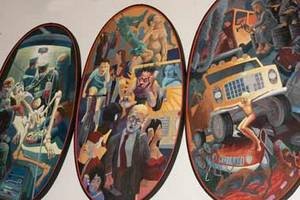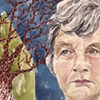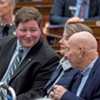Published September 5, 2007 at 9:09 p.m.
This year’s South End Art Hop features some 500 artists, but there’s a good chance only one of them made a painting of Attorney General Alberto Gonzales kissing the ass of President George W. Bush. Titled “Inamorato,” it’s one of seven large-scale, oval, tempera-and-acrylic works that compose Al Salzman’s “Garden of Earthly Delights,” which is on view through October 13 at Speaking Volumes on Pine Street. With characteristically clever wordplay, the Fairfield artist calls this 55-inch-by-18-foot collection an “anti-septych,” and the nose-holding “septic” connotation is scathingly clear. The seven paintings, incendiary in both color and content, tackle subjects that Salzman disdains. Three of the paintings specifically address the Bush administration and its military, while titles such as “Affluenza,” “Emissions” and “HMO” hint at ongoing ills of modern capitalist society. “I think we’re living in a very dire time, semi-fascist,” he declares. “What motivates me are pressing issues and our screwed-up national priorities.”
Salzman appropriated for this collection the title of a 1504 triptych by Dutch painter Hieronymus Bosch; what the two artists’ works also have in common is an astute judgment about the foolish and damnable ways of humankind. There is nothing “delightful” about the subject matter of Salzman’s septych, except in the sense that such baldly critical work — appallingly rare in these times — is a breath of fresh air. With an emperor-wears-no-clothes clarity, his visual manifesto is in the lineage of art history’s finest protests: Picasso’s “Guernica,” Goya’s “Disasters of War,” the anti-authoritarian works of George Grosz, and Mexican social-realist murals.
In fact, the Brooklyn-born Salzman says he was inspired by a show he saw earlier this year at the Metropolitan Museum of Art featuring early German expressionists, including Grosz. The works, a collective indictment of the Weimar Republic, were “explosive politically and explicit sexually,” he recalls. “I came away wondering where the political art is now.”
Some is actually filed away in scrapbooks in Salzman’s own studio — political cartoons and commentary he’s created over the past 25 years and routinely presented to members of the Vermont Legislature. “Health care and livable wage are two of my biggest issues,” Salzman explains. The pen-and-ink line drawings have also addressed such issues as property tax reform, homelessness and education funding. “Sometimes people in the legislature call me to do a cartoon about a specific topic,” he notes. “I don’t know how effective the [cartoons] are, but they make me feel good.”
For Salzman, art and politics are nearly inseparable. Except, perhaps, in the classroom: He retired four years ago after 18 years as an art teacher at the St. Albans City School. It’s one of the rare institutions he praises. Salzman and his colleagues had “complete autonomy,” he says, to create a general art curriculum for grades K-8. “Vermont is amazing in that respect — art is mandated still,” Salzman exclaims, pointing out that in the No Child Left Behind era, math and reading are emphasized, often at the expense of the arts and other subjects. “I call it ‘No Child Left Untortured,’” he comments wryly.
Salzman has painted since his own school days in New York, but until last year had not displayed his work for more than three decades. He seems perfectly content that wife Gail, a widely exhibited and highly regarded artist, has earned all the painting praise so far. Salzman has found public creative outlets in cartooning and occasional theatrical gigs — not surprisingly, his scrappy personality translates to a strong stage presence. But now, 73 years old and retired, Salzman has some artistic time to make up. In 2006 he showed five years’ worth of what he calls his “subway paintings” at the Fletcher Free Library. But most viewers will probably see “Garden of Earthly Delights” as Salzman’s Burlington debut, and it makes a stunning entrance.
The first visual impression of these paintings is actually their shape. Salzman says he “got connected to the oval” about 10 years ago, following a stint with tondos, or round paintings. He likes the oval because, he says, “It eliminates the dead corners,” but the form also lends the paintings a classic art-historical look.
The immediate second impression is, of course, the content. “Inamorato” was obviously completed before the AG’s recent disgrace and resignation. The painting’s composition is simple but laden with innuendo. Bush is leaning on both hands against his desk; his gaze, upward and over his right shoulder, is a perfect mixture of arrogance and swoon. Gonzales is kneeling behind him and kissing the president’s bare buttocks — the pulled-down pants add a perversely sexual element — while Vice President Dick Cheney and Secretary of State Condoleeza Rice look on approvingly. In the background are a multi-paned window and, naturally, an American flag. A round, bright-red rug and a plain wooden armchair complete the picture.
And then there is the color. Salzman enhances the distastefulness of this sycophantish scene with lurid hues. Cheney’s skin has a cold blue pall; a grinning Rice, one hand on the president’s shoulder, is tarted up in a tight red dress; Bush’s skin is jaundiced; and Gonzales is several shades of pink. From embarrassment? One thinks not.
Color plays a similarly powerful role in six of the seven paintings in “Garden.” In “Affluenza,” fleshy nudes loll in luxury around a swimming pool as, beyond a cudgel-bearing guard, vigilant Rottweiler and barbed-wire fence, a huddled mass of naked, clearly suffering people appear in burning orange-red. In Salzman’s vivid rant against the hegemony of cellphones, titled simply “Contact,” multicolored individuals engage in a variety of tasks — even swinging on a trapeze — and all have one hand, with phone, clapped to an ear. By overlapping the figures and jangling the hot and cool colors against one another, Salzman effectively illustrates both the implied verbal cacophony and the desperate human need for connection.
In “Terrorgation” (see cover), Bush administration personnel are specifically implicated in torture: A shadowy Rumsfeld holds a hose over an overflowing vat of water as Cheney, sleeves rolled up for the job, waterboards a naked, bound prisoner. In the background, General Colin Powell beats a snare drum while a blue-faced Bush grips Condi’s dark hair à la detainee with one hand and brandishes a sword with the other. With the exception of Powell, all the men are wearing red ties. The backdrop, again: an American flag.
In startling contrast to his brilliantly colored paintings, “Mad Dogs” is executed in black and white — or, more specifically, inky black and a range of murky grays. This shadowy palette suits its once-hidden subject matter: the torture and humiliation of prisoners at Abu Ghraib. It also emphasizes Salzman’s skill with light. Despite the unsettling jumble of vicious dogs and naked, hooded men, this is a beautifully painted work.
Salzman’s figures are rendered in a style that mixes realism — the likenesses are dead-on — and caricature. It’s a technique that perhaps reflects his fascination with cartooning in general and protest art in particular. With saturated pigments, crowded compositions and disturbing imagery, Salzman translates the hell-in-a-handbasket stuff of current events into original artworks that are full of life.
These days, with “Garden of Earthly Delights” behind him, Salzman is spending quality time in his actual garden. “I’ve developed a fixation on dragonflies,” he reveals, noting that he rescued a greenfaced pond skimmer from near death just the other day. Though his Brooklyn accent betrays his urban roots, Salzman confesses, “Now the noise and activity and chatter of the city drives me nuts. That kind of stimulation is hard to get rid of, but here I can.” His isolated 23-acre bit of paradise, 40 miles from Burlington, is indeed a good place to study dragonflies . . . or humans.
“For my next series, I’m thinking of doing full-length portraits of all my friends naked,” Salzman enthuses. “My first one will be of me, inside a swarm of dragonflies.” And, of course, an oval.
More By This Author
About the Artist

Matthew Thorsen
Bio:
Matthew Thorsen was a photographer for Seven Days 1995-2018. Read all about his life and work here.
Matthew Thorsen was a photographer for Seven Days 1995-2018. Read all about his life and work here.
Speaking of...
-

Q&A: Catching Up With the Champlain Valley Quilt Guild
Apr 10, 2024 -

Video: The Champlain Valley Quilt Guild Prepares for Its Biennial Quilt Show
Apr 4, 2024 -

Q&A: Meet a Family in Waterbury That Embraces Halloween Year-Round
Feb 14, 2024 -

Video: Goth Family in Waterbury: Sarah, Jay and Zarek Vogelsang-Card
Feb 8, 2024 -

Q&A: Art Entrepreneurs Tessa and Torrey Valyou Celebrate 15 Years of New Duds
Oct 11, 2023 - More »
Comments
Comments are closed.
From 2014-2020, Seven Days allowed readers to comment on all stories posted on our website. While we've appreciated the suggestions and insights, right now Seven Days is prioritizing our core mission — producing high-quality, responsible local journalism — over moderating online debates between readers.
To criticize, correct or praise our reporting, please send us a letter to the editor or send us a tip. We’ll check it out and report the results.
Online comments may return when we have better tech tools for managing them. Thanks for reading.















































